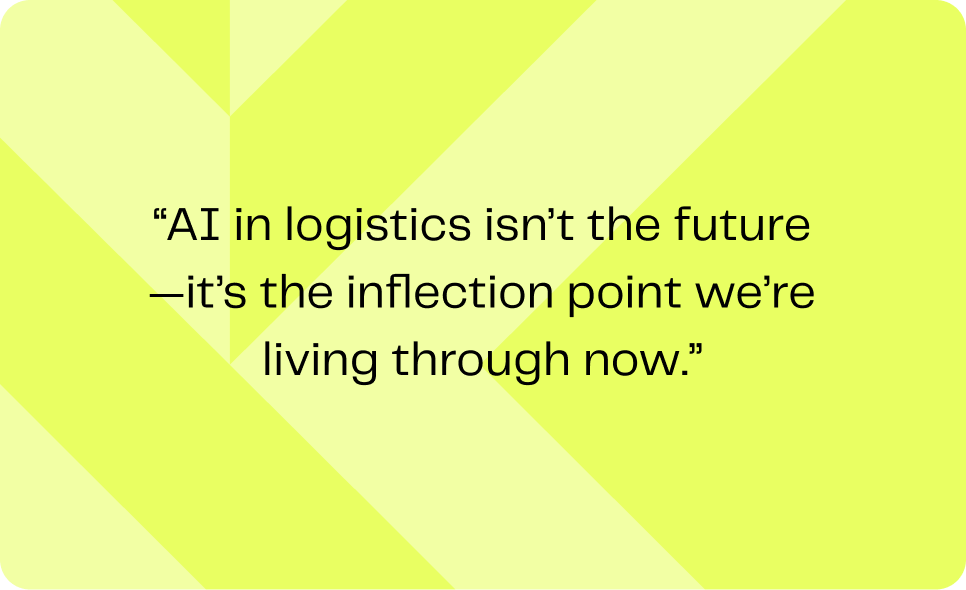The New Frontier: AI in Logistics
The logistics industry has always adapted to technological shifts—from the invention of the shipping container to the rise of enterprise resource planning systems. But artificial intelligence represents something more fundamental: a true inflection point.
AI isn’t just a new tool; it’s a catalyst for reimagining how logistics work gets done. And unlike previous waves of innovation, its impact is immediate, measurable, and scalable.
AI: The Fourth Technological Inflection Point
Across industries, AI is being compared to the rise of the PC, the internet, and the cloud. In the context of logistics and global trade, it’s even more urgent.
While technologies like blockchain promised transformation, AI is delivering it. Forwarders, customs brokers, and supply chain operators are already leveraging AI to automate manual tasks, minimize errors, and achieve new levels of productivity.
The logistics sector is notoriously document-heavy and process-intensive. AI changes that by parsing, processing, and extracting data from unstructured formats at scale. It doesn’t just speed things up—it rewrites what’s possible.
Practical Wins: Where AI Delivers ROI Now
At Raft, we’ve seen firsthand how logistics teams are using AI to reduce operational burden and improve customer service. Here are three areas where AI in logistics is already making a real impact:
1. Accounts Payable (AP) Invoice Automation
Processing freight invoices—especially those buried in PDF attachments or JPEG scans—can take hours of manual effort. AI-powered platforms now extract, validate, and process these invoices automatically, freeing teams from the repetitive task of data entry.
“Over 35% of our invoices now pass straight through without any human intervention. It’s been a huge win for our efficiency.” David Thompson, Finance Manager at Future Forwarding
2. Customs Document Preparation
AI reads and interprets customs documentation, reducing the number of touchpoints in a traditionally complex and compliance-driven workflow. This reduces delays, avoids rejections, and ensures faster cross-border movement.
3. Email & Communication Ingestion
Operational inboxes are full of critical updates from customers, carriers, or customs authorities. AI models can triage, tag, and respond to these messages, ensuring no time-sensitive information gets missed and that teams stay focused on exceptions, not every notification.
These are not future use cases. They’re live deployments with measurable results.

AI in Logistics Is About Augmentation, Not Replacement
One of the most important things to understand about AI in the supply chain is this: it’s not about removing people. It’s about empowering them.
AI takes on the repetitive, time-consuming tasks. Logistics professionals handle the high-value decisions, customer relationships, and problem-solving that still require human judgment.
It’s an evolution from human-powered operations to AI-assisted orchestration, enabling faster responses, improved accuracy, and stronger customer outcomes.
From Hype to Operational Value
Making AI work in the real world requires more than plugging in a new platform. Success depends on:
- Structured and accessible data
- Defined operational goals (e.g., faster cycle times, fewer manual touches)
- Cross-functional buy-in from operations, finance, and compliance teams
AI is not a one-size-fits-all solution—it works best when paired with real operational knowledge and a clear orchestration strategy.
Logistics, Reimagined
We’ve reached a new era in logistics digital transformation. AI in the supply chain is not just about efficiency—it’s about rethinking how work flows, how data is used, and how teams collaborate across borders and functions.
At Raft, the future of logistics belongs to teams who embrace AI not as a trend, but as a fundamental shift in how value is created.
Ready to explore what AI can do for your operations?
Download our AI Logistics Trends White Paper or Book a demo with our team
